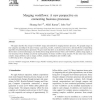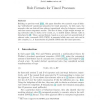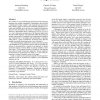2173 search results - page 204 / 435 » An operational semantics for skeletons |
DSS
2006
13 years 10 months ago
2006
This paper describes the concept of workflow merge and methods for merging business processes. We grouped merges in four categories according to the type of merge: sequential, par...
ENTCS
2002
13 years 10 months ago
2002
Building on previous work [15,8], this paper describes two syntactic ways of defining `well-behaved' operational semantics for timed processes. In both cases, the rules are d...
AAI
2010
13 years 5 months ago
2010
In this paper, we propose a proof system for reasoning on certain specifications of secure authentication systems. For this purpose, a new logic, sequence-indexed linear-time temp...
SDM
2012
SIAM
12 years 1 months ago
2012
SIAM
The Knowledge Discovery Toolbox (KDT) enables domain experts to perform complex analyses of huge datasets on supercomputers using a high-level language without grappling with the ...
TLDI
2010
ACM
14 years 7 months ago
2010
ACM
ML modules are a powerful language mechanism for decomposing programs into reusable components. Unfortunately, they also have a reputation for being “complex” and requiring fa...



